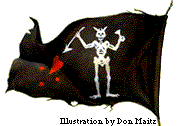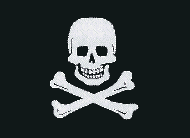

![]()
False Colors


![]()
False Colors
Usually a ship flew the flag of the country that owned her, but not pirate ships. Pirates would sometimes deceive passing ships by flying the flag of a friendly country. Pirates would carry onboard flags from several different countries, flying the one they hoped would get them closer to their victims. This was known as "false colors."
![]()

White and Red Flags
Pirates had a reputation for cruelty and violence. They hoisted flags to scare passing ships, in hopes they would surrender without too much of a fight. When chasing another ship, they often flew a white flag. If the ship did not slow down, a red flag was hoisted, signifying blood. This sent the message to the ship that once the pirates boarded, no one would be spared.
![]()

![]()
The Jolly Roger
The most famous image of pirate terror
is the skull and crossbones flag, or the Jolly Roger. The main reason
for hoisting the flag was to frighten the pirate's victims into surrendering.
The more fierce the flag (or the pirate's reputation), the higher the chance
for immediate surrender. The first Jolly Roger appeared around 1700, when
Emmanuel Wynne raised one in the Caribbean. The flag caught on quickly
and pirates began designing their own flags. No one really knows
the origin of the name, Jolly Roger. It may have come from the French
jolie rouge which translates into "beautiful red", a reference
given to the blood red flags flown by earlier pirates, meaning no mercy
would be given ("no quarter given"), or death to everyone. The name
Old Roger was given by pirates later hanged on Rhode Island in 1723.
![]()
Flag Symbols
and Meanings
![]()

![]()
![]()